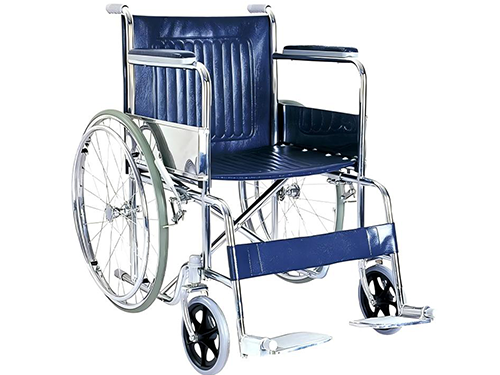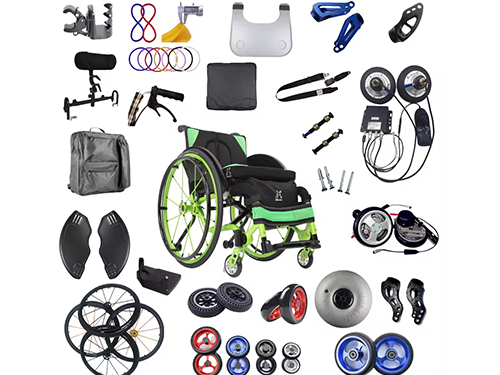
Wheelchair Buying Guide - Everything You Need to Know
2024-09-13 15:30
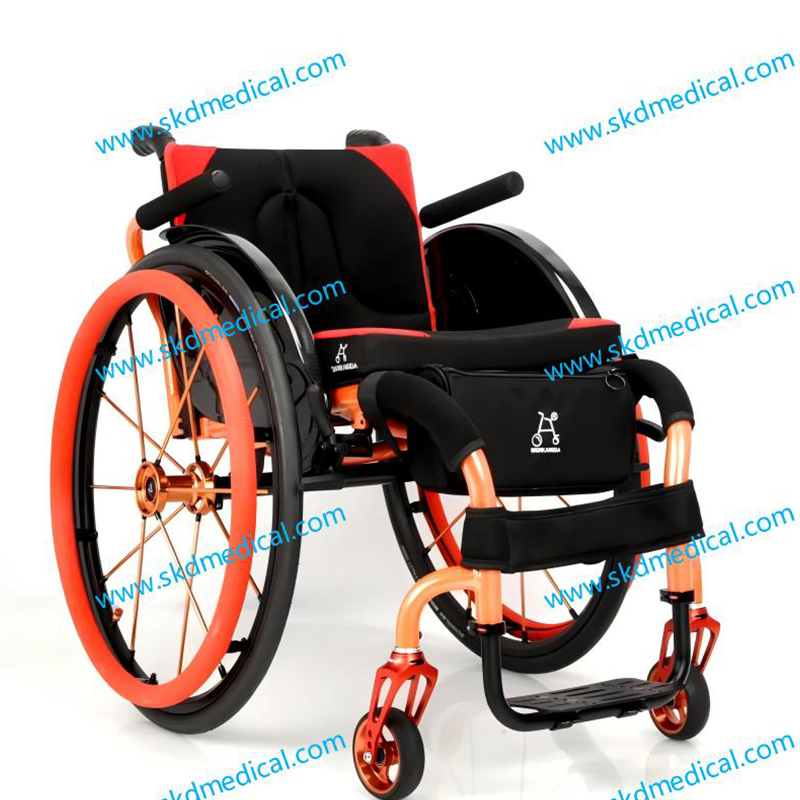
In today's society, wheelchairs have become an indispensable aid in many people's lives. Whether it is due to illness, old age, or accidents, wheelchairs can provide great convenience for people with limited mobility. However, facing the dazzling array of wheelchair products on the market, choosing a suitable wheelchair may not be a simple matter.
In the United States, there are millions of people using wheelchairs alone. So, how can you find the most suitable wheelchair for you among the many choices? This article will provide you with a detailed buying guide to help you make an informed decision.
Did You Know That There Are 3.3 Million Wheelchair Users in the United States Alone?
According to statistics, more than 3.3 million people in the United States rely on wheelchairs for daily activities. This huge number not only reflects the important role that wheelchairs play in life, but also reveals the broad prospects of the wheelchair market. The user groups of wheelchairs include the elderly, the disabled, those who are temporarily unable to move due to surgery or accidents, and patients who need long-term rehabilitation. Different needs have given rise to many types of wheelchairs, and each wheelchair has its own unique characteristics and advantages.
What Is the Role of a Wheelchair?
A Wheelchair Can Benefit the Following Groups of People:
● People who have difficulty walking or cannot walk
● People who feel severe pain when walking
● People who get tired easily when walking or cannot walk long distances
● People with paralysis or musculoskeletal problems
● Broken bones or leg or foot injuries
● People with severe balance or gait problems
● People with neurological problems
Do I Need a Wheelchair?
Before buying a wheelchair, the first thing you need to clarify is: do you really need a wheelchair? For some people, a wheelchair may be just a temporary transitional tool, such as during the recovery period after surgery, the user may only need a lightweight manual wheelchair to help them regain mobility in a short period of time. For people with long-term mobility impairment, choosing a comfortable and fully functional wheelchair is particularly important.
Several Key Questions to Evaluate Whether You Need a Wheelchair:
Do You Have Long-Term Mobility Impairment?
If your mobility is limited and this situation will last for several months or even longer, a wheelchair will be a necessary tool.
Can You Walk Independently?
If your walking ability is severely limited, making it difficult to complete daily life independently, then a wheelchair will provide great convenience.
Do You Need to be Outdoors for a Long Time?
If you need to go out frequently and it is difficult for you to stand or walk for a long time, a wheelchair will provide you with effective help.
Are There Suitable Assistive Devices?
If crutches or walkers do not meet your needs, a wheelchair may be a better choice.
After clarifying these issues, if you find that a wheelchair can indeed help you better cope with the challenges in your life, then the next step is to choose the right wheelchair.
What to Consider When Buying a Wheelchair?
When choosing a wheelchair, you need to consider the user's physical condition, lifestyle, budget, wheelchair comfort, wheelchair adjustability and portability to ensure that the wheelchair you buy can meet your needs.
User's Physical Condition
The user's physical condition needs to be considered from 3 aspects:
● Weight and height
● Physical strength
● Medical condition or degree of mobility limitation
Different wheelchairs have different load-bearing capacities and sizes. Choosing a wheelchair that fits the user's body type not only improves comfort, but also increases safety. In addition, the user's upper limb strength will determine whether they are suitable for a manual wheelchair. If the upper limb strength is insufficient, a power wheelchair may be a better choice.
If the user's mobility is severely limited, you may need to choose a wheelchair with additional support and safety features, such as a model with head support, tilt function or anti-tipping device.
Lifestyle
Consider the user's daily activities, such as indoor or outdoor use, whether they need to ride for long periods of time, and whether they travel frequently. These will affect the type of wheelchair you choose. Does the wheelchair need to adapt to environmental conditions such as narrow door frames, steps, ramps, muddy roads, etc.? This will affect the design and functional requirements of the wheelchair.
Budget
The price of wheelchairs varies greatly, ranging from a few hundred dollars to a few thousand dollars. Electric wheelchairs are generally more expensive than manual wheelchairs, and customized wheelchairs or wheelchairs with special functions are even more expensive. In addition to the initial purchase cost, long-term costs such as maintenance, servicing, and parts replacement should also be considered.
Wheelchair Comfort
There are two aspects to consider when it comes to wheelchair comfort:
● Seat and backrest
● Wheelchair accessories
The material and design of the seat and backrest directly affect the user's comfort. Some wheelchairs are equipped with memory foam cushions or adjustable backrests for additional comfort. When purchasing a wheelchair, you should also consider whether you need accessories such as footrests, armrests, and headrests? These accessories can significantly improve the user's comfort.
Adjustability and Portability
Some wheelchairs have adjustable seat height, armrest angle, and footrest position to meet the needs of different users. If the wheelchair needs to be carried or stored frequently, it is important to choose a lightweight, foldable wheelchair.
What Are the Types of Wheelchairs?
When buying a wheelchair, it is crucial to understand the different types of wheelchairs and their Pros and Cons. Common wheelchairs on the market can be divided into 2 types: Powered Wheelchairs vs. Manual Wheelchairs.
Powered Wheelchairs
Powered wheelchairs are battery-powered and suitable for people with weak upper limb strength or severe mobility limitations. They usually have multiple speed settings, steering functions, and comfortable seats, which can easily cope with different environments indoors and outdoors. Powered wheelchairs are the best choice for those who do not have much upper body strength. This includes those who are severely paralyzed or use a wheelchair for most of the day. Instead of pushing the chair with wheels, powered wheelchairs can be easily controlled using joysticks on the armrests. However, powered wheelchairs are larger, heavier and more expensive than manual wheelchairs.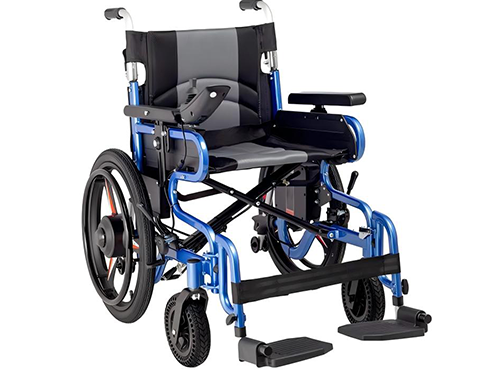
Powered Wheelchair Pros:
● No manual operation required, easy to use.
● Provides more independence and suitable for long-term use.
● Some electric wheelchairs are also equipped with tilt, lift and other advanced features to improve comfort.
Electric Wheelchair Cons:
● Higher price, usually more than a few thousand dollars.
● Requires regular charging, limited battery life.
● High repair and maintenance costs.
Manual Wheelchairs
Manual wheelchairs, also known as self-propelled wheelchairs. Manual wheelchairs are driven by the user manually pushing the wheels forward, suitable for users with good upper limb strength. They are usually lightweight and low-priced, suitable for short-term or temporary use. For those who have smaller vehicles but do not travel frequently, they can buy manual wheelchairs. Doing so helps avoid the hassle and cost of traveling with electric wheelchairs.
Manual Wheelchair Pros:
● Relatively cheap, suitable for users with limited budgets.
● Simple structure, easy to carry and store.
● No electricity required, can be used at any time.
Manual Wheelchair Cons:
● Manual operation may be difficult for those with weak upper limb strength or long-term users.
● Fatigue may occur when using complex terrain or for a long time.
What Are the Types of Electric Wheelchairs?
Electric wheelchairs can be classified according to different functions and designs. Common types of electric wheelchairs are: standard electric wheelchairs, heavy electric wheelchairs, folding electric wheelchairs, and lightweight electric wheelchairs.
Standard electric wheelchairs - This type of wheelchair is the most common and suitable for daily use. It is powered by batteries and motors and has basic drive functions and easy operation. They usually go farther than other electric wheelchairs, are simple in design, and are suitable for use on flat ground. However, they may be bulky and difficult to transport, and cannot accommodate those who need smaller, larger, or heavier chairs.
Heavy electric wheelchairs - Heavy electric wheelchairs are equipped with stronger drive systems and larger wheels, with reinforced frames and larger seat sizes, which are heavier than standard wheelchairs. Heavy electric wheelchairs are powered by batteries and heavy motors, and have strong power and stable structures. They can travel on various complex terrains. They are suitable for obese users.
Folding electric wheelchairs - Folding electric wheelchairs are designed for portability and can be easily folded for storage. They are powered by smaller batteries and motors and are suitable for users who travel frequently. This type of wheelchair is usually lightweight and easy to carry. But the Cons are that the travel distance is not as good as a standard wheelchair, and it also cannot accommodate those who need a larger or heavier chair.
Lightweight electric wheelchairs - Lightweight electric wheelchairs combine the convenience of an electric wheelchair with the lightness of a manual wheelchair for those who want to use it in different environments. They are usually lighter than standard electric wheelchairs, but still provide enough power and comfort. The con is that they can't accommodate those who need larger or heavier chairs.
What Are the Types of Manual Wheelchairs?
Manual wheelchairs can also be divided into many types according to different designs and functional requirements. Common types of manual wheelchairs are: standard manual wheelchairs, sports manual wheelchairs, multi-functional manual wheelchairs, and children's manual wheelchairs.
Standard manual wheelchairs - Standard manual wheelchairs are the most common type and are relatively cheap. They meet basic wheelchair needs and are suitable for short-term use or people who need assisted mobility. They are simple in design, lightweight, easy to operate and carry. They may not accommodate those who need smaller, larger or heavier chairs
Sports manual wheelchairs - Sports manual wheelchairs are designed for sports and competitions, usually made of lightweight materials, compact in structure, and easy to move quickly. Suitable for users who participate in sports such as wheelchair basketball and wheelchair tennis.
Multifunctional Manual Wheelchairs - Multifunctional manual wheelchairs are usually equipped with additional comfort and safety features, such as adjustable seats, backrests, and footrests. These wheelchairs are suitable for users who use them for a long time, providing better support and comfort.
Children's Manual Wheelchairs - From a safety point of view, electric wheelchairs are not suitable for children. Therefore, children's manual wheelchairs are designed for children. They are smaller in size and lighter in weight, taking into account the possible adjustment needs during growth. They usually come with colorful designs and are suitable for younger users.
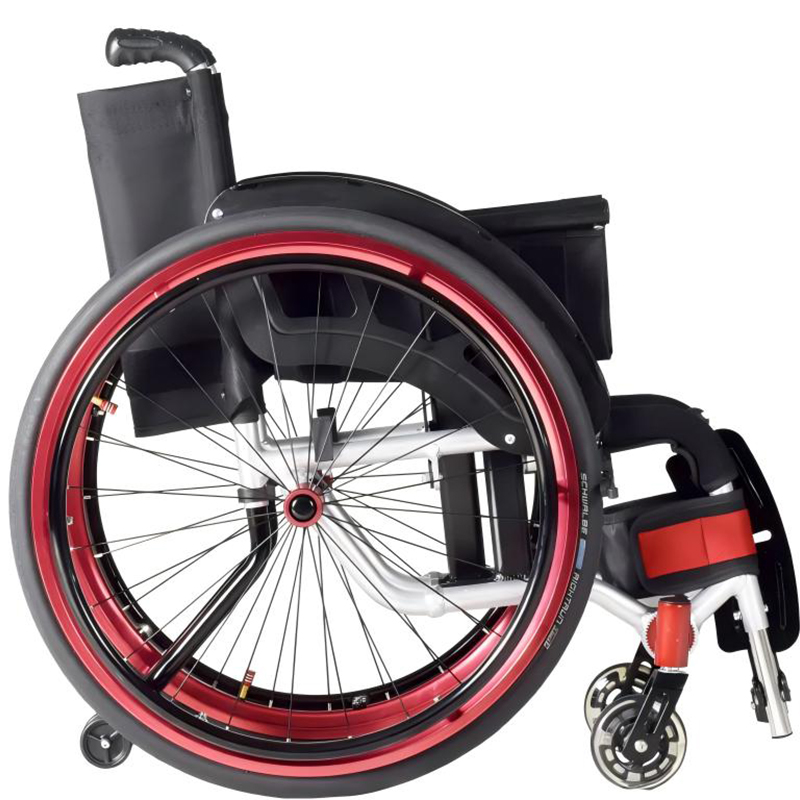
Steel Wheelchairs Vs. Aluminum Wheelchairs, Which One is Best?
Whether it is an electric wheelchair or a manual wheelchair, it is generally made of steel, aluminum, or a mixture of the two. Each material has Pros and Cons, so it is necessary to know which material can meet your needs.
Steel Wheelchairs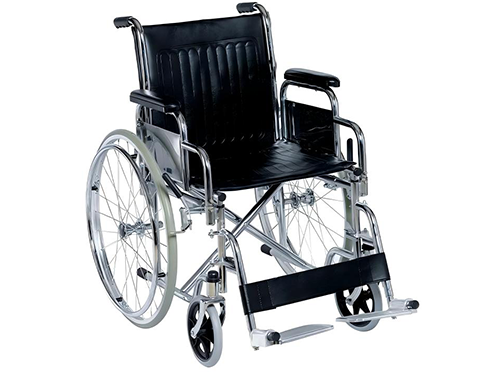
Most standard manual wheelchairs are made of steel. It is a stronger material, and steel wheelchairs are suitable for heavier users because of their sturdiness. Although they are usually heavier than aluminum wheelchairs, they excel in stability and durability. However, the biggest Cons of steel wheelchairs is that they are heavier than aluminum wheelchairs and are not suitable for users who need to carry or travel frequently. If you have weak strength, a steel wheelchair may not be suitable for you.
Steel Wheelchair Pros:
● Strong structure and strong load-bearing capacity.
● Suitable for long-term use, wear-resistant and durable.
Steel Wheelchair Cons:
● Heavy weight, inconvenient to carry and move.
● Not suitable for users who need to carry or travel frequently.
Aluminum Wheelchairs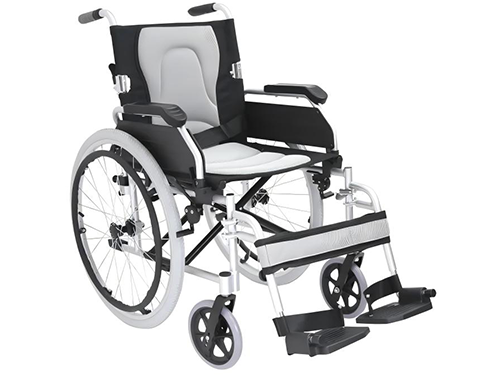
Aluminum wheelchairs are popular in the market for their lightness and durability. They are usually suitable for users who need to carry or store frequently. If you need a wheelchair that is easier to operate and transport, aluminum is the best. But the Cons it brings are that the price is more expensive than steel wheelchairs and the load-bearing capacity is poor.
Aluminum Wheelchair Pros:
● Lightweight, easy to carry and store.
● Corrosion-resistant, suitable for long-term use.
Aluminum Wheelchair Cons:
● The load-bearing capacity is not as good as that of steel wheelchairs, and may not be suitable for users with heavier weight.
● The price is usually higher than that of steel wheelchairs.
What Are the Accessories for Wheelchairs?
There are many types of wheelchair parts and accessories that can be selected and customized according to the specific needs of the user. Here are some common wheelchair parts and accessories:
Seat and Backrest
The seat and backrest are important accessories that directly affect comfort. Different materials and designs can provide different levels of support and comfort. Memory foam seat cushions, gel cushions, and air cushions are all common choices that can relieve discomfort caused by long-term riding.
Footrest
The height and angle of the footrest can be adjusted to accommodate users of different heights and postures. Some wheelchairs are also equipped with removable or flip-up footrests to facilitate users getting in and out of the wheelchair.
Armrests and Hand Rests
Armrests and hand rests can provide additional support to help users maintain balance and comfort. Height-adjustable armrests are suitable for users of different heights and body shapes, while padded armrests can improve riding comfort. Desk-length armrests are an excellent choice for those who sit at a desk for a long time. They provide ample support for your elbows and make it more comfortable to sit at a proper distance from the desk.
Headrest and Neck Support
For users who need to use a wheelchair for a long time, headrests and neck supports are very important accessories. They can effectively reduce neck and shoulder fatigue and provide better posture support.
Wheels and Tires
The material and design of the wheels directly affect the maneuverability and adaptability of the wheelchair. Solid tires are highly wear-resistant and suitable for use on flat ground; pneumatic tires provide better shock absorption and are suitable for complex terrain. Swivel wheels and detachable wheels can increase the flexibility and portability of the wheelchair.
Safety Belts and Anti-Roll Devices
Seat belts and anti-roll devices are designed to improve the safety of users. Safety belts can fix the position of users and prevent accidental slipping; anti-roll devices can prevent wheelchairs from tipping over on steep slopes or uneven ground. Suppose you decide to use a wheelchair with a seat positioning belt. In this case, it is crucial to choose a suitable one that can be adjusted to a support length without putting too much pressure on your abdomen.
What Is the Width of the Wheelchair?
The width of a wheelchair will vary depending on the type and manufacturer. However, the width of a standard wheelchair ranges from 25 inches to 36 inches. Electric wheelchairs tend to be narrower than manual wheelchairs, starting at about 23 inches.
Here Are Typical Widths By Wheelchair Type:
Manual wheelchairs: 25-36 inches
Powered wheelchairs: 23-32 inches
Narrow transport wheelchairs: 21-25 inches
Heavy duty wheelchairs: 32-40 inches
How Do I Choose a Wheelchair Size?
When shopping for a wheelchair, dimensions are very important to consider. According to Dimensions, a typical wheelchair is 36 inches (91.4 cm) tall, with a seat height of about 19.5 inches (49.5 cm), a seat width of between 16 and 20 inches (40.5-51 cm), and an overall width of 25 inches (63.5 cm). Here is an introduction to these main dimensional parameters:
Wheelchair Height - Wheelchair height depends on the user's physical condition and personal needs, and the typical wheelchair height is generally 36 inches (91.4 cm). A higher backrest provides more upper body support for users who need extra support, while a lower backrest allows more upper body freedom of movement for users with stronger upper extremities.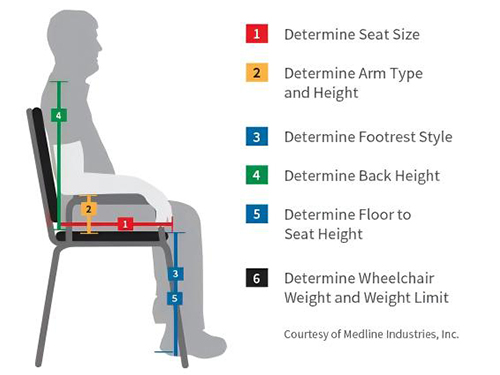
Seat Height - Seat height affects the user's leg comfort and foot support. The right seat height should allow the user's feet to be firmly planted on the ground or on the footrest, and the thighs are at a right angle to the seat. The standard seat height is about 19.5 inches (49.5 cm).
Seat Width - Seat width is one of the most basic wheelchair dimensions. The right seat width should allow the user to sit with good support for the hips and thighs, while leaving enough space on the sides to prevent rubbing. Standard wheelchair seat widths are usually between 16 and 20 (40.5-51 cm) inches, but there are also wider or narrower options.
Overall Width - The overall width of the wheelchair determines whether the wheelchair can pass through narrow spaces such as door frames and hallways. Generally, the overall width of the wheelchair is 5 to 8 inches more than the seat width, about 25 inches (63.5 cm). Users who need to use the wheelchair frequently in narrow spaces should pay special attention to this parameter.
Seat Depth - The seat depth determines the user's comfort when sitting. The right seat depth should allow the user's back to be close to the backrest, while leaving about 2 inches of space in front of the knees. A seat that is too deep will cause the user to slide off, while a seat that is too shallow will not provide adequate leg support.
Summary of the Wheelchair Buying Guide
When choosing a wheelchair, it is very important to understand your needs and the characteristics of different wheelchairs. By comprehensively considering the user's physical condition, lifestyle, budget, comfort, portability and other factors, you will be able to find the wheelchair that suits you best. If you have special needs or questions about a certain type of wheelchair, it is recommended to consult a professional or try it yourself to ensure that you purchase the most suitable product.

